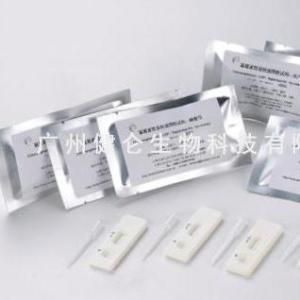


|

| 产地 | 国产 |
| 品牌 | 中国 |
| 货号 | 129 |
| 用途 | 于疑似环境污染物中鼠疫菌抗原样本的科研调查,不能用于临床使用。 |
| 包装规格 | 10t一盒 |
| 是否进口 | 否 |
鼠Plague疫菌F1抗体检测试剂盒使用说明书
【产品名称】
通用名称:鼠Plague疫菌抗原检测试剂盒(胶体金法)
【预期用途】
本品仅用于疑似环境污染物中鼠Plague疫菌抗原样本的科研调查,不能用于临床使用。
【检验原理】
本品采用兔抗鼠Plague疫菌特异性抗体和羊抗兔 IgG 分别包被硝酸纤维素膜作为检测线和质控线,胶体金标记的兔抗鼠Plague疫菌
抗体及其它试剂组成,应用层析式双抗体夹心原理定性检测样本中的鼠Plague疫菌抗原。
【主要组成成分】
组份
1 人份/袋
10 人份/盒
鼠Plague疫菌抗原快速检测卡
【适用仪器】 无
【储存条件及有效期】
试剂于 0-30℃保存,有效期 12 个月。生产日期、失效日期见标签。
【样本要求】
环境中污染物样本,如疑似鼠Plague疫菌污染的土壤、灰尘和水或物体表面、动物皮毛的拭子。
【检验方法】
样品制备:取环境中污染物样本,如疑似鼠Plague疫菌污染的土壤、灰尘和水或物体表面、动物皮毛的擦拭子,浸于 1mL 生理
盐水中,取上清作为样品检测液。
检测过程:取一个试纸卡,撕开外包装,吸取样品检测液,滴加 150μL 样本于试剂圆孔中,第 30 分钟判读。
【结果释义】
阳性结果:试剂窗口“C” (对照) 和“T”(检测)处出现 2 条红色沉淀线为阳性,即检出。
阴性结果:试剂窗口仅“C”处出现 1 条红色沉淀线为阴性,即未检出。
试纸卡失效:试剂窗口“C”处无红色沉淀线,即试纸卡失效。
【检验方法的局限性】
本产品仅用于疑似环境标本的科研调查,阳性结果需结合其它方法进行确证且不能作为临床诊断的依据。
【注意事项】
1. 试纸卡取出后应立即使用,以保证试剂使用时干燥,因为试剂在空气中暴露时间过长后会受潮失效。
2. 试剂用过后放入包装袋中,集中消毒后再处理,以防污染环境。
想要了解更多,咨询添加以下方式咨询:
【腾讯Q】:506 563 099 郑小姐
【CALL】: 159 863 56723 郑小姐
【公司地址】广州清华科技园创新基地番禺石楼镇创启路63号二期2幢101-103室

The disease is transmitted through multiple pathways and is caused by the capsule, multiple toxic antigens, endotoxins and toxic enzymes, hyaluronidase, fibrinolytic enzymes, etc.
Classified by different modes of dissemination:
1. pestis among rats generally occurs before human epidemics. Spread through rat flea bloodsucking.
2. Human pestis is infected by the bite of infected rat fleas. It can also be caused by slaughtering infected animals, invading through damaged wounds, or being infected by inhaling aerosols containing this bacterium. Common clinical disease types include:
(1) The gland pestis is mainly transmitted by wild rats to house rats, and when the house rats bite people, pestis bacilli will be injected under the skin of the human body. Entering the lymph nodes again to reproduce and invade, the most common invasion is the inguinal or axillary lymph nodes, causing lymph node swelling, suppuration, and systemic poisoning, with a high mortality rate.
(2) Septic pestis secondary to glandular pestis, when the body's resistance is extremely damaged, bacteria invade the blood stream, septicemia occurs, and the mortality is extremely high.
(3) Pulmonary pestis or secondary pestis is directly caused by inhaling pestis bacilli in the air, which is highly infectious and easy to spread in cold seasons. This type of disease is the most dangerous. The secondary pulmonary pestis is a complicated pneumonia caused by the bacteria in patients with glandular pestis or septicemia pestis invading their own lungs. It is spread by the patients' breathing and has a very high mortality.